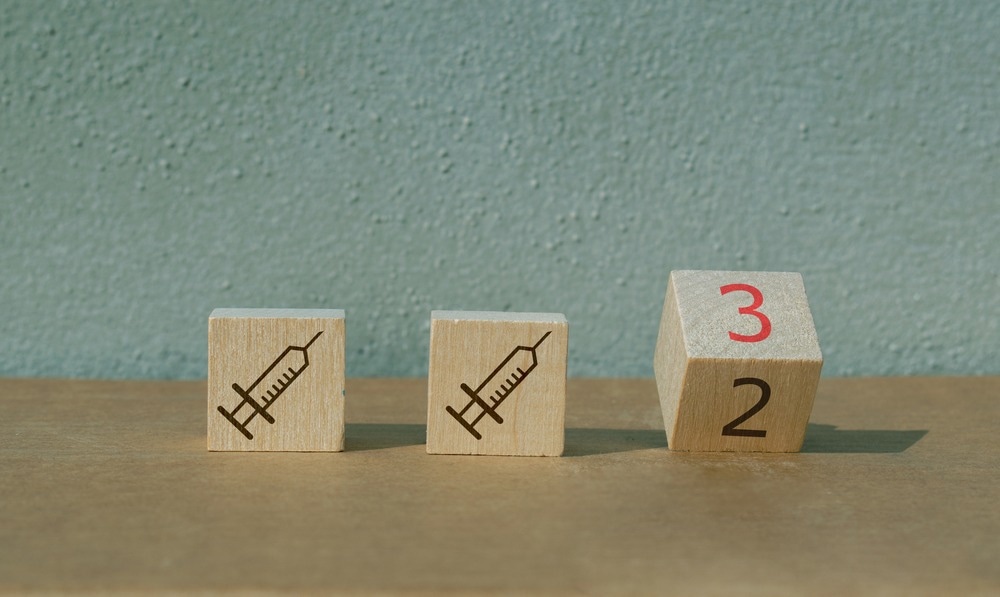 By Neha MathurReviewed by Danielle Ellis, B.Sc.Sep 29 2022
By Neha MathurReviewed by Danielle Ellis, B.Sc.Sep 29 2022In a recent study published in Cell, researchers investigated whether the time of booster (third dose) vaccination relative to severe acute respiratory syndrome coronavirus 2 (SARS-CoV-2) infection is a crucial determinant of the elicited immune response; in particular, the antibody and B-cell responses.
 Study: Interval between prior SARS-CoV-2 infection and booster vaccination impacts magnitude and quality of antibody and B cell responses. Image Credit: No-Mad/Shutterstock
Study: Interval between prior SARS-CoV-2 infection and booster vaccination impacts magnitude and quality of antibody and B cell responses. Image Credit: No-Mad/Shutterstock
Background
A booster dose of messenger ribonucleic acid (mRNA) coronavirus disease 2019 (COVID-19) vaccines confer adequate immune protection against severe illness by triggering potent antibody and memory B-cell responses. However, a patient’s infection history could modulate the effect of booster vaccinations. As SARS-CoV-2 exposure increases through vaccination, infection, or both, it is unclear how timing between exposures modulates these responses.
About the study
In the present study, researchers recruited 66 adults scheduled to receive a third (booster) dose of BNT162b2 or mRNA-1273 vaccine between October 2021 and March 2022. They collected their blood samples at baseline (day 0) and two-time points after booster vaccination i.e., days 30 and 60.
The team divided the study cohort on day 60 into three groups. The first group had 44 SARS-CoV-2 uninfected individuals, and the second and third groups had 11 individuals each, infected before booster and post-booster vaccination, respectively. In those infected after booster vaccination, Omicron BA.1 was the suspected infecting SARS-CoV-2 variant of concern (VOC), whereas members of the prior-infected group had infections by other SARS-CoV-2 variants.
All the study participants had similar demographics and vaccine schedules except lower age of the post-infected group than the uninfected and prior-infected groups. More importantly, the time lapse between vaccination and post-boost infection and prior infection and vaccination had a median of 29 days and 160 days, respectively.
The researchers used a multiplex assay to measure serum immunoglobulin G (IgG) antibodies against spike (S) proteins of ancestral SARS-CoV-2 strain B.1 and nine variants. The nine variants were sublineages of Alpha, Beta, Delta, and Omicron sub-variants BA.1, BA.2, and BA.3. They used a mixed-effects model to evaluate temporal differences between the three study groups. Next, the researchers used a pseudovirus-based assay to measure serum neutralizing antibody titers against B.1, Beta, Delta, and Omicron BA.1.
Further, the team used spectral flow cytometry (FC) to evaluate B-cell responses to the booster vaccine. The 21-marker screening panel comprised six tetramers for measuring immune responses against the B.1 S subunit 1 (S1), its receptor-binding domain (RBD), and N-terminal domain (NTD). They also used it for identifying B cells that bound RBD and NTD of both B.1 and Omicron BA.1. Furthermore, the team investigated whether post-boost BA.1 infection and the booster dose altered the ratio of dual B.1/BA.1 to single B.1 RBD or NTD binding.
Study findings
The authors noted an increase in neutralizing antibody titers from baseline to day 30 in all three groups. By day 60, titers had decreased in the prior-infected group against B.1 and six variants, plateaued in the uninfected group, and surged slightly in the post-infected group against B.1 and three variants. The study model showed the high significance of SARS-CoV-2 time and exposure status for all three study groups combined but not between uninfected and post-infected groups.
The combination of high baseline titers with modest increases post-boost in the prior-infected group translated into lower fold increases between baseline and day 60 than in the uninfected and post-infected groups. Intriguingly, the fold increases in neutralizing antibody titers against all 10 S proteins were moderately higher in the post-infected group compared to the uninfected group.
While neutralization increased from baseline to day 60 in the uninfected and post-infected groups, in contrast to antibody binding, neutralizing titers did not increase between baseline and day 60 in the prior-infection group. Again, the mixed-effects model showed that these temporal differences were highly significant for all three groups combined and between each group.
The authors noted B.1 RBD, NTD, and dual B.1/BA.1 RBD and NTD-binding B cells peaked at day 30 in the uninfected group. However, in the post-infected group, their frequency continued to surge from baseline to day 60. Conversely, in the prior-infected group, frequencies of S-binding B cells against B.1 RBD, NTD, and B.1/BA.1 NTD declined between days 30 and 60. These temporal differences translated into higher fold increases between baseline and day 60 in the post-infected group compared to the two other groups and higher in the uninfected than prior-infected group for both RBD and NTD and dual counterparts.
The dual B.1/BA.1 to single B.1 binding ratio for RBD was the highest in the post-infected group and lowest in the prior-infected group. Notably, it increased from baseline to day 60 in all three groups. For NTD, the ratios were similarly higher in the uninfected and post-infected than in the prior-infected group. The B-cell response was robust in the uninfected and post-infected groups, with the latter having an additional boost from the breakthrough infection. However, it remained poor in magnitude and breadth in the prior-infected group.
Conclusions
Taken together, the study results pointed out that recent prior SARS-CoV-2 infection is associated with a diminished response to the booster vaccine when compared to uninfected and post-boosted individuals. Therefore, neutralizing antibodies and B-cell responses to the booster did not increase between baseline and day 60. Indeed, the kinetics and magnitude of antibody binding and neutralizing titers were most strikingly different in the prior-infected group, which had muted antibody responses to the booster vaccine.